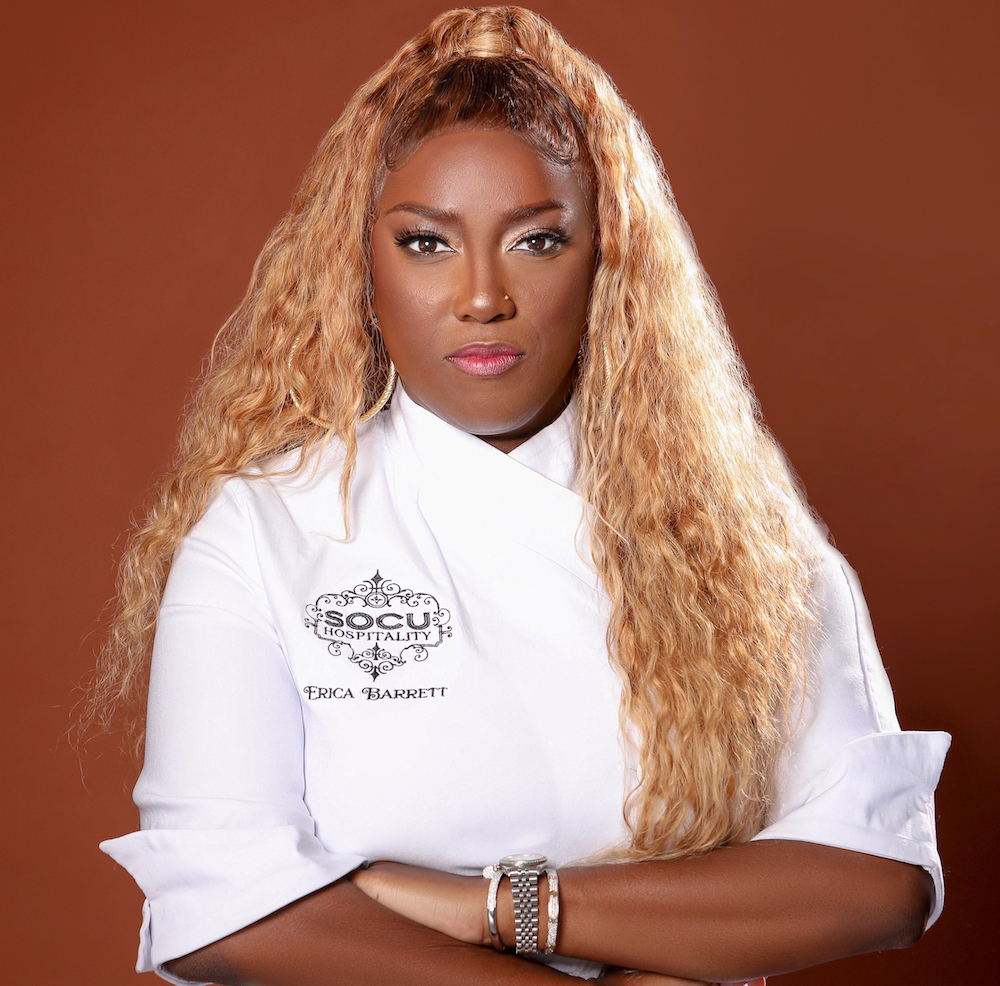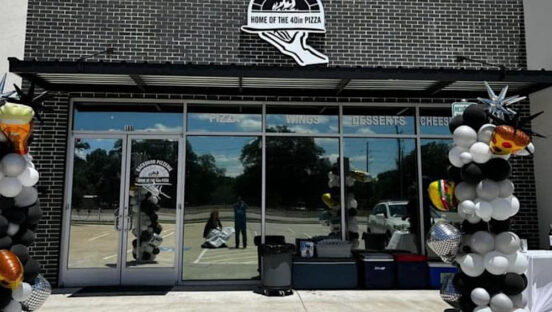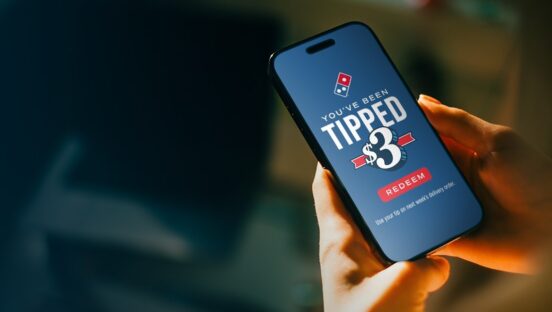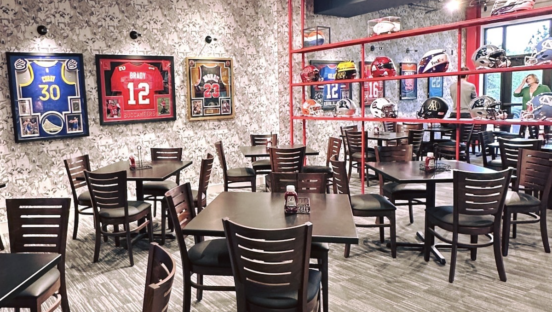By Rick Hynum
Erica Barrett, the founder of Dough Boy Pizza, is building the smart pizza kitchen of the future. With a location in Atlanta, another in Birmingham, Alabama, and more on the way, Dough Boy is a high-tech yet chef-driven franchise concept that’s highly affordable to a pizza industry newcomer. PMQ profiled Barrett and her company on the cover of our August 2023 issue, but there was a lot more to the conversation. Here, we delve a little deeper, as Barrett talks about growing up as a picky eater, the Dough Boy menu, her experience with Shark Tank and more.
PMQ: Did you grow up in a family of chefs and cooks?
Erica Barrett: Actually I did. Well, I did, but I didn’t. My mom was a hairstylist, and she owned hair salons. And I hated being at the hair salons on the weekends. So, I had this wager with my mom, like, “Hey, let me stay home. I don’t wanna work in the hair salons on the weekends. I’ll take care of myself and teach myself how to cook.” So when I was around 12, she allowed me to start just staying home and make my own sandwiches and keep up the house and stuff.
My grandmother, however, was a big cook. She was actually my cafeteria lady when I was in Head Start preschool. It was pretty cool to have your grandmother as your cafeteria lady. She was an avid cook. She catered a lot and did a lot with the church and cooking there. She always was a subscriber to Southern Living magazine and would save those magazines. My grandmother didn’t have cable, so when we would go spend weekends with her, you didn’t have a choice but to either read or go to church. I opted to read the Southern Living magazines—I still have issues from the 80s and 90s that my grandmother put up for me, and I still take recipes from those as well.
Then my mom’s now ex-husband, my stepfather, was from Pine Hill, Alabama, a country boy. His mom passed away when he was 15, and he had five brothers and had to take care of them. He was an amazing cook. He taught me the basics of building flavor and making sauces, which we call gravy in the South. Everything is gravy. You know, meat gravy, brown gravy, white gravy, cream gravy. He taught me the basics of making those, so I can literally take oil and water and flour or corn starch at any point in time and make you some gravy in seconds. That’s the basics of the southern restaurants that I operate (SOCU Southern Kitchen and Oyster Bar). We make gravy from scratch, you know, to build flavor or rouxs. So those were the big influences in building my love and sparking my interest for food: my grandmother and my stepdad. My mom just wasn’t a cook, so I learned at an early age on how to feed my family.
Related: How Paul Stanley of KISS makes pizza at home

The Good Fellas Pizza (M. Gerard Photography)
PMQ: In addition to Dough Boy Pizza and SOCU, you own other businesses, too, right?
Barrett: I opened a catering company in 2010. It was called Fab Food ATL. It was short-lived, maybe two years, and I just started catering parties. And that’s when I started to create some of the dishes that I serve at my restaurants now. From there, I had an idea to start a breakfast line called Southern Culture and started that in around 2010, 2011. And I still own that company. It’s a food manufacturing company, so I make artisanal specialty food products for grocery stores and department stores. I pack 30 of my own branded items and sell to stores, and then I also pack [products] for my good friends that are in the industry who want to start their own product line. So I have several clients that I do co-packing for at a co-packing facility here in Georgia. That’s what I’ve been doing the longest.
PMQ: As you explained in the print story, you opened your second SOCU Southern Kitchen and Oyster Bar location in Birmingham, Alabama, and that’s when you also became interested in pizza. But the space you were looking at couldn’t support a large wood-fired oven. Tell us a little more about how the idea for Dough Boy Pizza evolved instead.
Barrett: Food is all that I know, right? So I started doing research on pizza. I was trying to put together this concept, and I realized that the pizza industry was growing even during the pandemic, as other sectors of food were kind of suffering. Everybody was ordering pizza. Pizza sales were growing. I’m like, okay, this is a good track to be on. People are buying more pizzas—consumers love it.
I also saw some really cool stuff going on with Blaze Pizza. I saw pizza and robotics. Everybody was investing in pizza. And I said, well, man, I need to do something different. So when I went to the National Restaurant Association Show, there was a tech pavilion, and they were asking, what does the restaurant of the future look like? How do we create restaurants of the future to solve labor issues, consistency of food and all of that stuff? And I said, well, I need to solve all of these problems.
Food is like working a math problem backwards, right? And I’m like, okay, the first thing I need to do is solve the two biggest problems, food and labor, and then consistency. So I built the restaurant backwards. I actually worked on the pizza recipes last because, I mean, come on, you choose good cheese, you’ve got good sauce and pepperoni, you’re a chef. I could put together a great pizza.
So I said, the first thing that I don’t like is high labor costs. It’s been really hard during the pandemic to have people that wanna come back to work. I don’t want my business to be fully dependent on the workforce—it’s temperamental and volatile. So, I said, you know what? Walmart’s doing it, Target’s doing it: Everybody has self-checkout. We’re gonna have a self-checkout pizzeria. You put in your own order.
So we built our concept from day one with self-ordering technology and digital screens where we can change our menus in real time. Everything can be changed in real time. So you don’t technically have outages. And what you have is what they get.
Related: Cicis Pizza puts AI to work as a social media intern

(Southern Culture Kitchen and Co.)
PMQ: And your employees only have to build the pies. They don’t have to learn how to make dough or anything like that?
Barrett: I said, we’re not gonna make our dough in-house. We’re gonna find somebody that does it in a commissary so that it’s consistent and we don’t have to, like, get in here four or five hours before we open and make dough. We not doing that, you know?
So, from a food cost perspective, we’re around 32%. The dough is made in a commissary factory in Italy and imported here. Our sauce is made in my factory. Remember I told you own a food manufacturing company. So, from a consistency standpoint, I make the sauce for all of my franchisees and then we distribute it. So, literally, all our employees do is come in, set up toppings an hour before we open, cut the lights on and let the customers put in the order, and they start assembling pies. It’s the easiest job ever. From a stress level, there isn’t any. It’s the coolest job ever because you know that the food is consistent and it’s gonna taste good.
PMQ: So how many human employees do you need?
Barrett: Per shift, usually one. One on the weekends, one to two. No more than two.
PMQ: So many pizzeria owners and pizzaioli take a great deal of pride in making their own dough fresh every day. Does it bother you that you don’t make your own dough in-house?
Barrett: It doesn’t bother me one bit. Not at all. If a product is good and somebody’s great at what they do, why take that away? What does making dough in-house prove to our customer if the pizza is good? It’s just extra work for us. I feel like, if you keep things in house, it should be for a reason. The secret is in the sauce, but I’m able to do the sauce because it’s something that I’m strong at, that I understand. I’m strong with manufacturing sauces. That’s not the case for dough.
Related: Would you top a pizza with baloney? This chef gave it a try
PMQ: Both of the current Dough Boy locations are in food halls. Will that always be your approach?
Barrett: We’re opening up our first drive-thru in Mobile this summer. And it’s funny because I didn’t want traditional drive-through technology. I said, if it’s archaic, I don’t wanna do it. So we’re developing an app. The app will be finished in about four weeks, and our customers will go on the app, place their order and show us their order retrieval number, and we give them a box of pizza.
So I’m talking to my director of ops yesterday, and I said, “Man, are we doing the right thing? Should we go back and do traditional drive-thru technology?” He’s like, “No, Erica, I think you’re on the right track.” Then I’m watching a commercial this morning, and guess what Domino’s is doing? You order through an app to go through their drive-thru now. We’re talking about a market leader that’s saying, “Hey, we’re changing our drive-thrus.” Domino’s is great at changing and adapting to the times. So we’re changing our drive-thrus where it’s app only, and Domino’s is doing it too. I was on the right track.
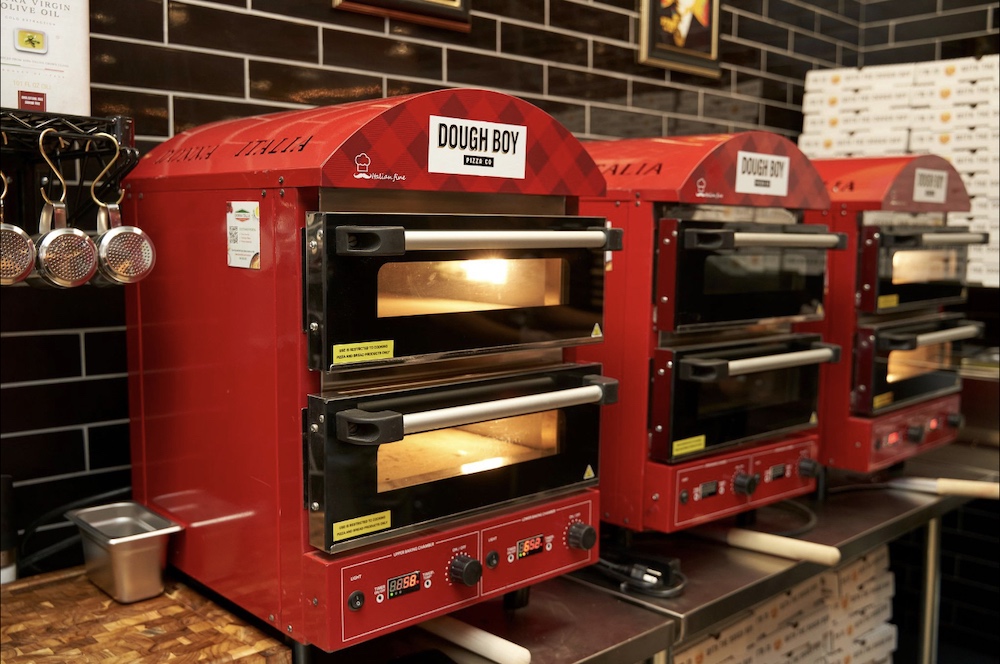
(Southern Culture Kitchen and Co.)
PMQ: I know that many pizza restaurants are considering the advantages of a smaller footprint now. How large—or small—is a Dough Boy Pizza drive-thru compared to a food hall location?
Barrett: The drive-thru building is actually, like, 1,200 square feet. My initial style is 150 square feet (for the food hall location). So we have stores that are opening up anywhere from 150 square feet to 1,500 square feet. And for the drive-thru, there’s a walk-in area. You can walk into the store and order your pizza, or if you have the app and you download it, you can utilize the drive-thru.
PMQ: So you’ve got brick-and-mortar operations coming now, but they’re strictly carryout and drive-through, is that right?
Barrett: Yep.
PMQ: You’ve described Dough Boy Pizza as fast food that’s fresh. Can you tell me about your menu?
Barrett: I came up with, I think, close to 12 specialty pies. We have a white pie that’s really good—the Lucky Luciano, with a proprietary white sauce, white cheeses, fresh herbs. Then we have our lobster pie. That’s really, really good. We have a Shrimp Alfredo. That’s amazing, with fresh garlic shrimp. The Goodfellas is by far our most popular pizza. That’s our meat lovers. We even have a vegan pie as well. It’s a vegan cheeseburger pizza with Impossible Crumbles, vegan cheese, fresh white onion, pickles and a vegan burger sauce.
With us, you can also build your own pie, with however many toppings you want. It’s your own personal 12” Neapolitan pie. You can have a white base, you can have a red base, but we’re adding non-traditional toppings like shrimp, lobster and short ribs, too. You see these videos on the internet, where people are saying, “Hey, I want this type of stuff. Our palettes have changed. I don’t just want pepperoni as a topping. I don’t just want sausage or mushroom or veggie pizza. I want an oxtail pizza. I want a shrimp Alfredo pizza. I want a curry shrimp pizza. I want a crawfish pie, and I wanna be able to grab it at my corner store. And I deserve that because I have a refined palette.” So we wanna be that pizza shop where we can say, you know what? You want lobster, you get lobster. You want short rib, you get short rib. You want shrimp, you get shrimp. You want chicken, we have chicken. You want vegan, we have vegan.

The Dapper Don (M. Gerard Photography)
PMQ: So this is a quick-service concept that’s serving artisanal pizza?
Barrett: One of the coolest things, I think, about the pizza shop is, we are a chef-driven pizza concept. We have a chef’s finishing table, so there’s always a Parmesan wheel at our pizza shops, and we can shave fresh Parmesan on top. You don’t get that at a typical pizza shop. And one of the newest things that we have added, which I’m super-excited about—and it’ll take place within the next few weeks—is, we’ve added hydroponic gardening for our herbs. We found these tiny hydroponic gardens on Amazon, you know, for 60, 70 bucks, and we’re growing our own fresh basil, cilantro and parsley in-house to garnish pizza. How cool and sustainable is that?
So we’re always thinking of ways to set ourselves apart and become the coolest pizza brand ever. And that comes from doing things that haven’t been done before. Because we’re small, we can adapt at the snap of a finger. We don’t have to have this huge 12-month rollout. I don’t ever wanna become that company. I wanna be the company where I call a franchisee and say, “Hey, next week, we’re implementing this as a special of the week. Let’s do it next week.” Or “Hey, today’s Taco Tuesday. We’ve got 72 hours. Here’s what you need to order from your supplier. Let’s do something really cool.” I want to be a pizza shop where entrepreneurs and our franchisees are able to change with us as well.
Being able to have hydroponic gardening inside of a pizza shop, it’s very easy to do. But how many pizza shops are actually gonna do it? It also prevents waste because we have this living garden inside of the restaurant. You’ve got a shelf life on that stuff, so let it stay in the root, you know? And who doesn’t want like this beautiful Margherita pizza with fresh mozzarella and then a touch of basil out of our hydroponic garden?”
PMQ: How did you end up appearing on Shark Tank?
Barrett: It was for my food products company, Southern Culture Kitchen, and the breakfast line that I still have. For my first attempt, which was season four, I applied, and they turned me down. They said, “We like your product, we like your personality, but you’re too new. You’ve only been in business two months. You don’t have enough sales. We don’t think the sharks will like this. Take a year, go build some sales and come back.”
And guess what I did? I went out and got sales. It took me a year to do it, but I said, “I want that opportunity. I’m gonna go back, and I’m gonna show them that I didn’t just take that with a grain of salt, that I wanna be great. I wanna be one of the sharks one day.”
So I sent the producers an email and said, “Hey, you interviewed me last year, you told me to go get some sales. Here’s what I’ve done. Will you interview me now?” And they interviewed me and they accepted me. So, I got a no from them initially, which has happened a lot. You know, you get nos, and then eventually you start to get a lot of yeses. I went through a lot of years of nos, but, you know, part of entrepreneurship is that no doesn’t mean no forever. It just means “Not right now, I don’t see it.” So one of the things I’ve learned as an entrepreneur is you only get one shot at this thing. Make people believe you the first time, you know, and actually do what you say you’re gonna do.
PMQ: And I assume that also helped you get your name out there and turned you into something of a celebrity chef?
Barrett: Absolutely. Shark Tank was just life-changing for me. It’s a gift that keeps on giving. It gave me brand exposure that you can’t buy. You know, you would need a million dollars to do that. I loves that experience. I learned a lot about being an entrepreneur. I learned a lot about being smart. I learned a lot about scalability. And just in a short amount of time that you’re interacting with the sharks and Mark Burnett and his team, you wouldn’t believe how much you learn about your business and yourself and how you can grow it and scale it. And I’ve taken those lessons with me for over a decade now to grow my brand.
So I’m forever thankful to Shark Tank. It really helped me hone my entrepreneurship skills. I love every single one of the sharks, and I respect all of them. They’re great people too: Barbara Corcoran, Kevin O’Leary, Daymond John and Mark Cuban. They are absolutely amazing. To go on Shark Tank is to do something that could change your life forever when it’s done right. That’s marketing that you can’t pay for. But you have to go for it.
Rick Hynum is PMQ’s editor-in-chief.

